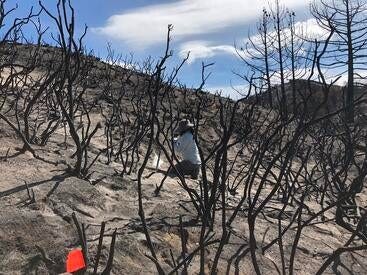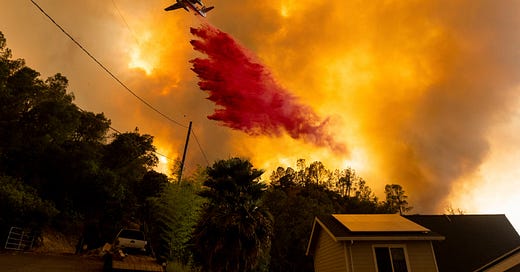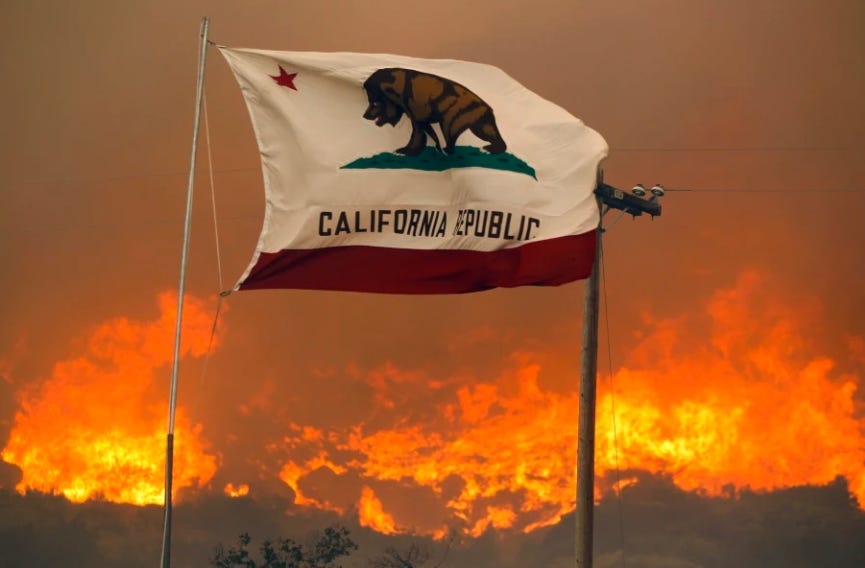CO₂ Worsens Wildfires by Helping Plants Grow per UC Scientists
The greenhouse gas is a floating fertilizer.......really (!)
Above: California dreaming. Not.
Preface
Ladies and Gents, both authors humbly hold PhDs in the sciences from back in the pre-woke days, and we are very fortunate, as it has given us a leg-up with regards to problem solving.
Earning a Bachelors, Masters or a PhD degree just isn’t what it used to be: it now seems that if one has enough time, cash, or influence, a higher degree can be obtained. This is part of a general issue with USA college students, as recently spotlighted in a Substack article by Hilarius Bookbinder, entitled: The Average College Student Is Illiterate.
Because of the downward trend in education and the politicization of climate change science in particular, we now call into question almost every peer-reviewed paper that we come across, and do our best to fact check and examine cited references just to make sure what we are reading is at least semi-legit.
With regards to the subject of this article and the ongoing debate about greenhouse gas warming, perhaps the most damaging occurrence was the declaration that CO₂ is a pollutant by the Supreme Court in Massachusetts v. EPA (2007). This ruling catalyzed worldwide CO₂ warming fears, and gave birth to the profiteering climate industrial complex.
Common sense would dictate that just because a court declares that CO₂ is a pollutant does not scientifically make it so. CO₂ is the only “pollutant” that we know of that is required for life on Earth, and that each time you exhale, you breathe out 40,000 ppm of CO₂. Maybe we should just stop living because we are exhaling polluting CO₂ ?
You Can Get a PhD and Still be an Idiot
The prescient Richard Feynman, a legendary physicist and Nobel Prize winner, generated many accurate, amusing and classic quotes, two of which are shown below:
Given the Feynman quotes above, and many others that are amusing and accurate, apparently Feynman had to deal with a fair number of absurdities and lame-brains during his time, but perhaps nothing like what we are dealing with today given the woke-mess and climate change cash grab.
In the same vein, the following article and press release from the University of California at Riverside caught our attention because it is an especially egregious example of the downward trend in education and the politicization of science.
Gene took a closer look, and picked up on a major flaw in the synthetic model used in this research paper that promotes the notion that CO₂ Worsens Wildfires by Helping Plants Grow. So without further adieu, we present the following short article and a quick analysis.
CO₂ Worsens Wildfires by Helping Plants Grow
By fueling the growth of plants that become kindling, CO₂ is driving an increase in the severity and frequency of wildfires, according to a UC Riverside study.

The worldwide surge in wildfires over the past decade is often attributed to the hotter, drier conditions of climate change. However, the study found that the effect of increasing levels of CO₂ on plants may be a bigger factor.
“It’s not because it’s hotter that things are burning, it’s because there’s more fuel, in the form of plants,” said UCR doctoral student in Earth and planetary sciences and study author James Gomez.
This conclusion, and a description of the eight model experiments that produced it, have been published in Communications Earth & Environment.
To convert light into food in a process called photosynthesis, plants require CO₂. Burning fossil fuels for heat, electricity, and transportation is adding increasing levels of CO₂ into the atmosphere. Plants use the extra CO₂ to make carbohydrates that help them grow, leading to an increase in biomass that burns.
Certainly, heat waves and drought occur more frequently in today’s climate than they did 50 years ago. These are conditions that cause plants to wither and die. As they dry out and die, they burn more easily. The models accounted for these effects on plants, as well as for different types of plants, and for the increase in atmospheric CO₂.
“Warming and drying are still important fire factors. These are the conditions that make the extra plant mass more flammable,” said UCR professor of Earth sciences Robert Allen.

The models analyzed by the research team all assumed an idealized 1% per year increase in atmospheric CO₂ concentrations since 1850. The idealized increase is meant to isolate the effects of the greenhouse gas on wildfire activity.
“These experiments are mainly looking at the contribution of CO₂ to changes in wildfire activity,” Gomez said. “That’s the only thing that’s changing in these models. Other drivers of climate change and wildfire activity do not change through time,” Gomez said. “This includes, for example, changes in other greenhouse gases like methane, as well as changes in land use.”
Seasons are still important factors in promoting wildfires, and fires still occur more often during “fire seasons.” Dry, windy conditions help spread the flames faster, increasing the size of the burned area. “However, our study shows the increase in fires during hotter seasons is driven by fuel load rather than an increase in the number of what some consider ‘fire weather’ days,” Gomez said.
Analysis by Gene Nelson of GreenNuke
The following is a key statement from “CO₂ Worsens Wildfires” paper:
The models analyzed by the research team all assumed an idealized 1% per year increase in atmospheric CO₂ concentrations since 1850. The idealized increase is meant to isolate the effects of the greenhouse gas on wildfire activity.
Gene’s take and the 1 % flaw:
As a consequence of compounding, a doubling of CO₂ concentration with a 1% per year increase occurs in only 72 years instead of 100 years. 175 years have elapsed since 1850, implying 2.43 doubling intervals. The 1850 CO₂ concentration is taken to be 280 parts per million (ppm). Multiplying 280 by 2 raised to the 2.43 power yields the product of 280 and 5.39 or 1,509 ppm. This modeled CO₂ concentration is considerably higher than the present value of 425 ppm by a factor of 3.5. This is one factor that calls into question doctoral candidate James Gomez's claims.
A far more basic issue is the improbability that CO₂ concentrations limit wild plant growth. For example, most of southern California is a desert. As can be seen by looking at these hills during the summer and fall, the hills are typically brown instead of their green color during the winter. This observation is consistent with the limiting factor for plant growth in this environment is the supply of water, not the supply of CO₂. Furthermore, a number of plant nutrients such as potassium and nitrogen may be in short supply in these wild environments.
While doctoral candidate James Gomez's claims regarding the role of CO₂ are likely a favored narrative by left-leaning UCR faculty members, his claims are unlikely to be a key driver in the damage caused by wildfires in locations such as Southern California. Instead, increasing human encroachment into the wildland (aka the urban-wildland interface) increases wildfire property damage.
Above: California dreaming. Not.
Stranger than Fiction Bonus: Unlearning Racism in Geoscience
Featuring the NSF-sponsored program Unlearning Racism in Geoscience (URGE), reading research and producing actionable strategies to promote anti-racism.
Non-fiction Bonus Section Film
Santa Ana Wind Driven Bel Air Fire • Design For Disaster 26:26 video
This 1962 documentary film produced by the Los Angeles Fire Department, describes the historic Bel Air / Brentwood wildfire that started on November 5, 1961 in the Bel Air community of Los Angeles. Over the course of three days, the wind-driven fire destroyed 484 homes, damaged 190 others, and burned over 16,000 acres. Amazingly, there was no loss of life attributable to the blaze.
The then $30 million disaster led to new laws in the City of Los Angeles to eliminate wood shingle roofs, and to clear dry brush away from homes. The film is narrated by actor William Conrad.













